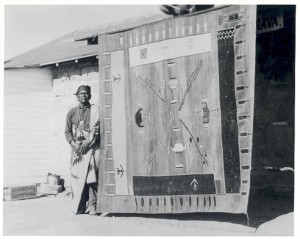Sandpainting tapestry by Hosteen Klah debuts at Museum of Native American History

The Museum of Native American History in Bentonville will debut a sandpainting tapestry by Hosteen Klah at 5 p.m. on Saturday, July 9.
The 8-foot by 8-foot tapestry is titled “Angled Corn With Holy People – Nightway Ceremony.” Circa early 1930s, it is made of Native handspun wool with Native and Aniline dyes. Klah was a weaver and powerful medicine man of the Navajo tribe. The exhibit of the Klah tapestry is from the Dr. Howard and Catherine Cockrill collection and will be on display through the end of 2016.
The Cockrills are Arkansas natives. Here’s what the Howard Cockrill had to say about their tapestry collection in a recent interview by MONAH Director Charlotte Buchanan-Yale:
What was the connection about sandpainting tapestries that sparked your passion to build this magnificent collection? Where were you when you encountered your first one?
Cockrill: “We discovered sandpainting rugs on a family trip out west after floating the Colorado River and stopped into a trading post. The Navajo rugs were fascinating, but it was not the geometric rugs I was drawn to…it was the sandpainting rugs that reminded me of primitive art–my favorite. And later, The Edwin Kennedy Collection inspired me. Edwin Kennedy, befriended me and he let me go down into his basement and experience his collection where I bought some of his rugs. His collection is now housed at the University of Ohio.”
The intent woven into the tapestries is so powerful. As a doctor did the original healing intent woven into some of these designs resonate with your passion to share the story of your collection?
Cockrill: “It was love at first sight. And as I read more about the culture and the healing ceremonies…the more I read I came to realize how sophisticated their culture was…The person at the trading post had been invited to the healing ceremonies…and they worked! Whether it can be called ‘psychosomatic’ or a good bedside manner relation with the patient that forms a bond of trust that promotes healing… it appealed to me.”
What was the first sandpainting tapestry you bought?
Cockrill: “It was the Yeibiachi Fire Dance Ceremony. Very colorful and well woven.”
What influence does Catherine have on the collection?
Cockrill: “Catherine is my co-pilot on the road trips to the reservations and trading posts. We have always enjoyed the trips together. Catherine and I usually approach the same tapestry that becomes part of the collection.”
When MONAH adds a new artifact, it is to add to the over 14,000 year history the museum tells of the first Americans and the diversity of cultures. Your textiles are so important in the story the museum tells. What was it about Museum of Native American History and Owner David Bogle that made you want to have your sandpainting tapestries on a rotating display?
Cockrill: “Originally Dr. Kent Westbrook introduced me to David. (The Kent and Jonnie Westbrook Collection is well known for American Indian art and expressions of cultures from Paleo to the Mississippian period.) As I got to know David, I felt a tremendous respect for his attention and appreciation to detail and his desire for excellence. David’s demand for quality makes the museum one of the finest Native American museums.”
What about the Hosteen Klah tapestry inspires you?
Cockrill: “Its historicity, that it was woven by Hosteen Klah, the most powerful of medicine men in the Navajo history. And that it was his skills as a medicine man and talent as a weaver that inspired Klah to reproduce a full sandpainting design within a rug. He was the first to do so. His weavings are scarce, and this one that will hang at the Museum of Native American History is a little over 8 feet by 8 feet.
How important is it to your collection?
Cockrill: “It is a fairly simple rug– a series of holy figures. But the very idea that he was the guy that was so revered in his culture is treasured.”
In this sandpainting design there are four corn plants in black, blue, white and yellow colors– representing gifts from the gods from north, south, east and west mountains, respectively. The plants emerge from stepped terraces that represent clouds. Male yeis with rounded faces and eagle feathers on their heads are sitting on the leaves and tassels of the corn plants. Colored birds sit atop each plant. The black stripe at the bottom of the design represents the earth, with seeds; it merges with a protective red and blue rainbow god.
The Nightway ceremony, in which this sandpainting is used may be performed for such problems as eye troubles, paralysis, crippling and headaches.
MONAH has free admission that comes with a greeting from a woolly mammoth skeleton. It is open from 9 a.m. to 5 p.m. Monday through Saturday and is located at 202 SW “O” St. For more information, call 479-273-2456, email [email protected], and visit www.monah.com.